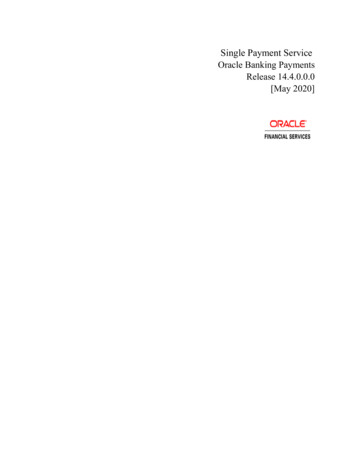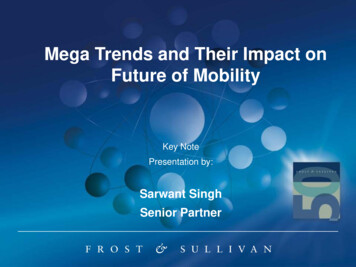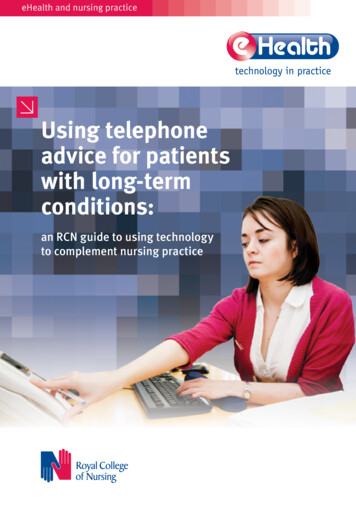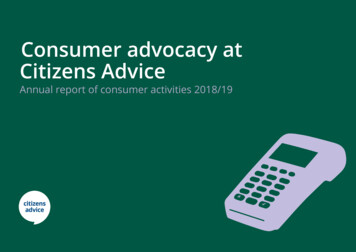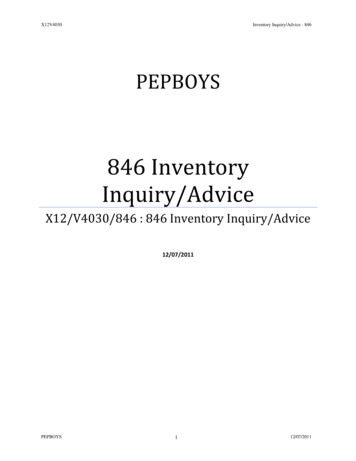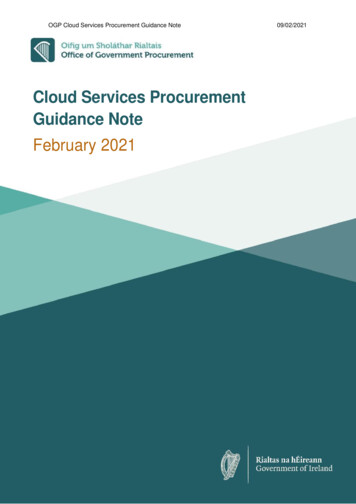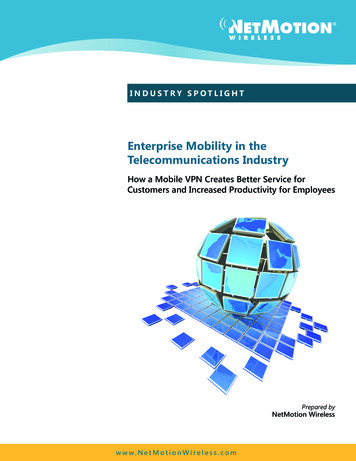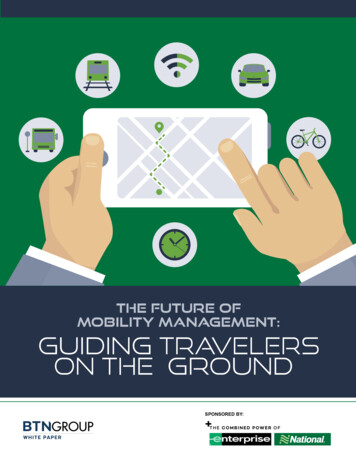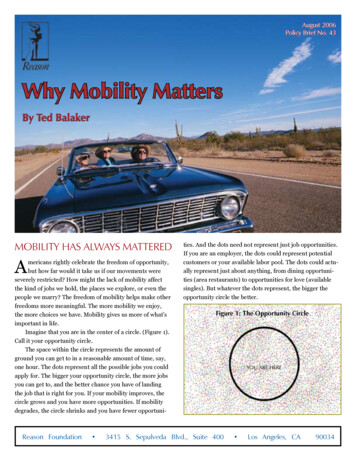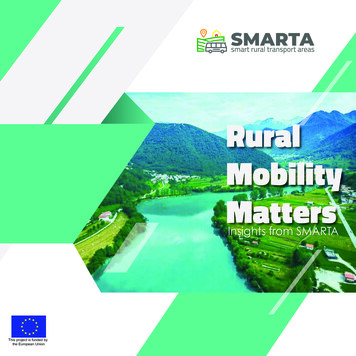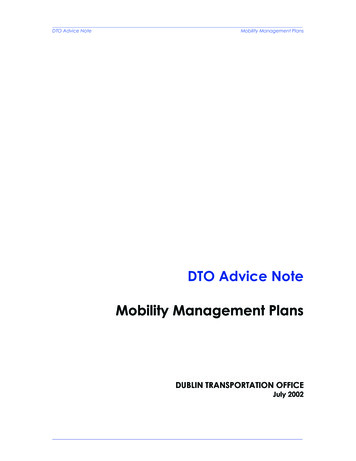
Transcription
DTO Advice NoteMobility Management PlansDTO Advice NoteMobility Management PlansDUBLIN TRANSPORTATION OFFICEJuly 2002
DTO Advice NoteMobility Management PlansPREAMBLEDTO Advice Notes – what and why are they?The DTO Advice Notes are intended as guidance for Local Authorities andothers involved in land use planning and development in the GreaterDublin Area. The need for additional guidance on integrated land use andtransport policy was identified in A Platform for Change and is beingprovided in the Advice Notes. They set out the DTO approach to variousissues within land use and transportation planning. The Advice Notes arenot issued as a fait accompli, but will be updated and revised based onfeedback received, new experience and knowledge. The DTO AdviceNotes are not Government Guidelines, have no statutory basis and are notpolicy statements. The Advice Notes set out what the DTO considers to becurrent best practice.In its role as a prescribed body, the DTO monitors planning applications,appeals and development plan policies in the GDA where these are likelyto impact significantly upon DTO Strategy. The Advice Notes set out in aneasily accessible form DTO attitudes towards various land use andtransportation issues which have been expressed by the DTO in variousreports on planning applications, appeals and development plans. TheAdvice Notes will be available to Local Authorities, consultants or any otherinterested parties, and will help to consolidate DTO opinion on a topic-bytopic basis. It is intended that they will be updated and augmented overtime, and build into a volume or set of notes helping towards theimplementation of the DTO Strategy.The Advice Notes are written to encourage debate and formulation of newopinions and attitudes to integration of land use and transportation, whichwill help to further the objectives of the Strategic Planning Guidelines andPlatform for Change. They are issued as a catalyst for discussion anddissemination of information relevant to the sustainable development ofthe GDA.July 20021
DTO Advice NoteMobility Management PlansDTO Advice NoteMobility Management PlansWhat is Mobility Management?Mobility Management can be describedas a transport demand managementmechanism, that seeks to provide for thetransportation needs of people andgoods. It can be applied as a strategicdemand management tool or as a sitespecific (or area-specific) measure. Theaim is to reduce demand for and use ofcars by increasing the attractivenessand practicality of other modes oftransport.What is a Mobility ManagementPlan?A Mobility Management Plan (MMP) is amanagement tool that brings togethertransport and other staff and sitemanagement issues in a coordinatedmanner. A successful plan can helpcompetitiveness by reducing transportcosts for both the employer and staffand provide a more conducive workingenvironment. It normally brings togethera package of measures tailored to theneeds of an individual work site or acollection of work sites. This packagegenerally includes measures to promoteand improve the attractiveness of usingpublic transport, cycling, walking, carsharing, flexible working or acombination of these as alternatives todrive-alone journeys to work. It canconsider all travel associated with thework-site, including business travel, fleetmanagement, customer access anddeliveries. It should be considered as adynamic process where a package ofmeasures and campaigns are identified,piloted and monitored on an on-goingbasis.The impact of these measures should bereviewed by the Local Authority andbusiness against a set of agreed targets,principally in relation to:July 20021
DTO Advice NoteMobility Management Plans A reduction in car journeys to andfrom the work site An increase in the number ofpeople who share their journeys bycar A reduction in the need to travel,especially during the rush-hourperiods Enabling staff to use alternativemodes of transportA mobility management plan may takethe form of a formally publisheddocument, which outlines its measuresand targets. Alternatively, it may simplyevolve over time as different initiativesare piloted.Depending on thecircumstances of the organisation, eitherapproach can be applied.When is a Mobility ManagementPlan required?Mobility management plans should berequired for developments which theplanning authority consider maygenerate significant trip demand. Theremay, however, be significant variationsto this threshold, subject to the specificlocation characteristics (town/citycentre, out of town), employment typeand work patterns (shift, standardworking day).Development for which mobilitymanagement could be applied includesthe following:Office,Office-based industrial,Other industrial,Retail (large one-off stores andtown/district centerdevelopments),Retail warehousing,Warehousing and distribution,Places of education.In the case of retail developments,mobility management plans mayinclude measures for employees,customers and suppliers. Mobilitymanagement for retail developmentmay require a different approach tomobility management for employmentgenerating uses. For education uses,measures may apply to staff andstudents/parents and for employmentsites such as office or industrial,employees, visitors (clients, suppliers)should be considered.Mobility management and theplanning ectives of sustainable developmentand the achievement of reduced cardependency.It is recognised that the preparation andsubmission of a detailed MMP in terms ofmeasures, timescales and targets maynot be possible as an integral element ofan outline or detailed planningapplication. The DTO also recognisethat there are problems withenforceability of mobility managementplans. Further advice on overcomingthese problems will be issued by theDTO.At the initial stage of submitting theplanning application, certaininformation on employment, tripdemand, distribution and trip patternsJuly 20022
DTO Advice Notemay not be possible to initiallydetermine. However, the likely impactof the development can be assessed ina traffic impact assessment or anenvironmental impact statement, withinwhich data pertaining to employmentlevels, access arrangements, proposedjunction/road modifications, trippatterns, volume and distribution wouldbe provided.A local authority may permit a stagedapproach to the provision of MMPinformation by the applicant – seeAppendix for details.Mobility Management PlansThe motivations for anemployer/developer toimplement mobility managementmay include: The need to improve accessibilityto the worksite for employees andcustomers, which may help inretaining staff and enhancingcompany image;The desire to promote a moreflexible working environment;The need to increase staff numberswithout the need to expand sitefacilities or car parking provision;The desire to reduce costsassociated with off-site parking,business mileage and other costoverheads; To facilitate the intensification ofexisting site use (associated withan expansion of operations), whilstcomplying with local authorityplanning conditionsJuly 20023
DTO Advice NoteMobility Management PlansAppendix – Staged Approach to preparation of MMP’sboth within and in the vicinity ofthe site. The plans should clearlyidentify the positioning of thebuilding(s) within the site relative tothe site boundary and proposedaccess arrangements relating to allmodes.First StageOn submission of the application, theapplicant should be required to submitthe following as part of an “outlinemobility management plan”. Estimate of the numbers ofemployees/ customers/ clients/students and their likely travelcharacteristics (arrival/departuretimes, work related travel), basedon conditions at similardevelopments, the scale of thedevelopment (floor areas) andland use type(s);Provision of an outline of publictransport services (existing andproposed) that serve the locationwithin the timeframe: Preparation of a statement on thenature and extent of facilities (hardmeasures) and initiatives (softmeasures) that will be consideredfor provision both within and in thevicinity of the site, that wouldfacilitate and encourage the useof non-car modes. An outline of the likely modal splitfor the following scenarios:of the development’scompletion, or phases of itscompletionwithin 5 years of thedevelopment’s completion;Information on future publictransport services to serve the sitewill be available from theIntegrated Framework Plan forLand Use and Transportation. Preparation of a conceptual planindicating existing and proposedpedestrian and cycle routes withinthe site and between the site andpublic transport services, localfacilities such as shops andrestaurants, and strategicpedestrian and cycle routesidentified in the development planor already in existence. This planshould also identify existing orpotential severance or safetyproblems associated with theselinks, outlining mitigation measures Opening year On completion of each phase 5 years after opening or 5 yearsfollowing completion of finalphaseThe modal split targets should beconsistent with those specified inthe Traffic Impact Assessment. Outline of how MMP measures willbe implemented and managed.Second StageAs a minimum requirement, the followingmeasures and a commitment to theirimplementation should be securedthrough planning conditions and/or anagreement between the local authorityand the applicant. Staff Travel and Attitudinal Survey –on completion and occupation ofthe development or phase of thedevelopment, a travel surveyshould be undertaken to identifyJuly 2002I
DTO Advice Notetravel to work details, other traveldetails (work related travel),transport options/attitudes todifferent modes of transport, workdetails, demographic details. In aphased development, this shouldbe undertaken oncompletion/occupation of eachsubsequent phase. Establishment of MMP co-ordinatorand steering group within theorganisation(s) located within thedevelopment, through which alldecisions should be made inrelation to the identification,funding, promotion andimplementation of hard and softmeasures.Implementation of all hard andsoft measures identified andagreed with the local authority inthe first stage, including thefunding/part funding ofinfrastructural measures within andMobility Management Plansbeyond the site. Such measuresmay include the following:oThe development of a carsharing schemeoA parking managementscheme which restricts parkingavailability to specific groupssuch as car sharers (ofparticular importance whererestrictive parking standardsare applied)oProvision of car pool for use byemployees during businesshours – to reduce the need forcar commutingoProvision of a range of cyclefacilities including sheltered,secure cycle parking locatedclose to main entry points tobuildings,oMMP Review, at intervals (asspecified in the relevantplanning condition) ofimplementation, by anappointed consultant inrelation to modal split targetsand agreed measures. Thiswould include a repeat staffand attitudinal survey.July 2002II
Mobility management for retail development may require a different approach to mobility management for employment generating uses. For education uses, measures may apply to staff and students/parents and for employment sites such as office or industrial, employees, visitors (clients, suppliers) should be considered. Mobility management and the
